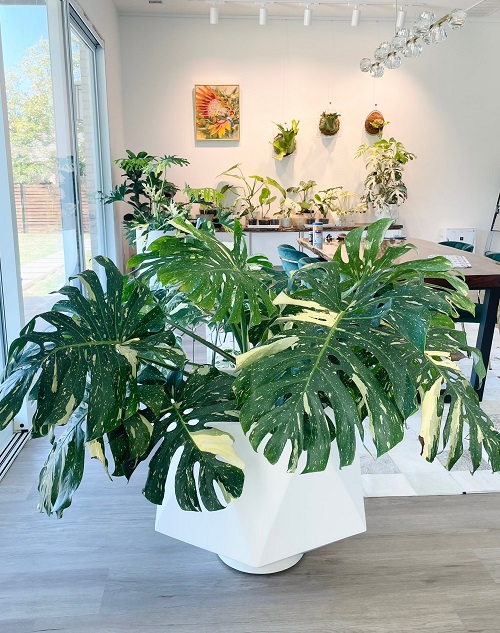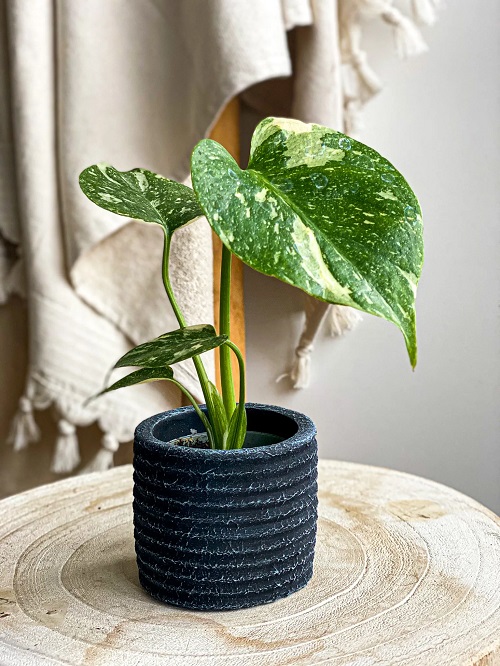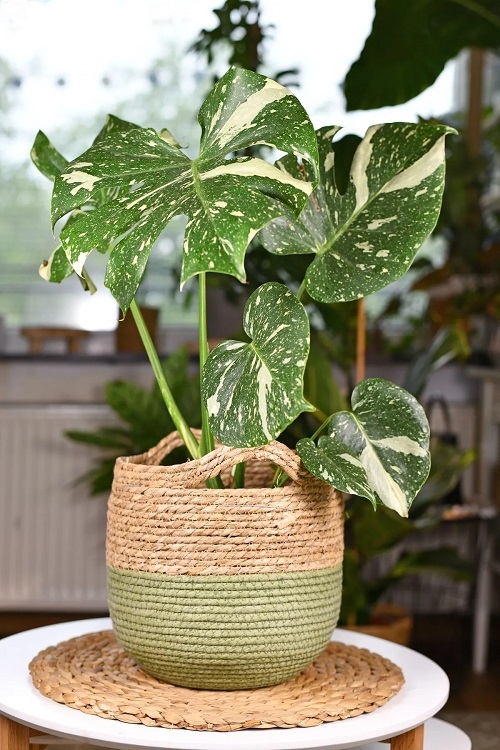Thai Constellation Monstera is for anyone looking for a plant with large and multicolor leaves! Here are all the details to grow it!
Thai Constellation Monstera—a celestial spectacle in the form of a houseplant! With its cream-colored, marbled patterns splashed across deep green leaves, this extraordinary variety is like a galaxy unto itself, turning any space into an interstellar experience. It’s not just a plant; it’s an otherworldly masterpiece that commands attention!
Check Monstera Acacoyaguensis Care and Growing Guide here
Thai Constellation Monstera Information
The Thai Constellation Monstera belongs to the Araceae family. It is not native to Thailand; it is believed to have originated in the rainforests of Central and South America. This plant is known for its distinctive appearance. Its leaves are large and heart-shaped with creamy-white marbled patterns on dark green foliage.
In terms of growth rate, the Thai Constellation Monstera is considered to be moderately fast-growing when provided with suitable conditions. It can reach a height of around 2 to 3 feet indoors and up to 6 feet or more when grown outdoors.
Regarding flowers, the Thai Constellation Monstera can produce flowers, but they are small, inconspicuous, and not a prominent feature of the plant. This species is primarily grown for its attractive foliage rather than its flowers.
Learn Monstera Adansonii Propagation here
The foliage of this Monstera is its most striking feature, with its unique variegation patterns making it a popular choice among plant enthusiasts. The creamy-white marbling on the dark green leaves gives it a visually appealing appearance.
Propagating Thai Constellation Monstera
Methods to propagate Thai Constellation Monstera :
- Stem Cuttings
- Air Layering
- Division
The easiest method to propagate Thai Constellation Monstera is through Stem Cuttings:
- Select a healthy stem with at least one node (where leaves and roots develop) and a few leaves.
- Ensure the cutting is around 6 to 12 inches long.
- Using a clean, sharp pair of scissors or pruning shears, cut the stem just below a node.
- Place the cutting in a glass of water or directly in a well-draining potting mix. If using water, change it regularly to prevent rot.
- Keep the cutting in a location with bright, indirect light and maintain a warm, humid environment.
- Roots should begin to develop in a few weeks. Once the roots are a few inches long and the cutting has grown some new leaves, it can be potted into a larger container or planted in the garden if desired.
Learn How to Grow Monstera Pinnatipartita here
Best Pot Size for Growing Thai Constellation Monstera
For Thai Constellation Monstera, a pot size of 6-8 inches in diameter is suitable for young plants, while mature ones thrive in 12-14 inch pots. Choose a well-draining material like terracotta or ceramic, promoting moisture balance.
Learn How to Get a Monstera to Bloom here
Requirements for Growing Thai Constellation Monstera Indoors
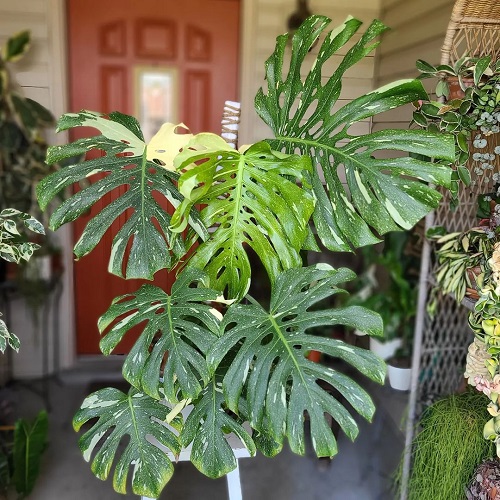
Light
The Thai Constellation Monstera thrives in bright, indirect light when grown indoors. Place it near a north or east-facing window, where it receives gentle, filtered sunlight.
Avoid direct sunlight, as it can scorch the leaves. This lighting condition helps maintain the plant’s variegation and overall health.
Soil
Thai Constellation Monstera thrives in well-draining, aerated soil. Here’s the best potting mix you must use for a thriving plant:
- Coir or Peat Moss: 40%
- Perlite: 30%
- Orchid Bark: 20%
- Worm Castings: 5%
- Activated Charcoal: 5%
Read Monstera Albo Care and Growing Guide here
Water
Water when the top inch of soil feels dry, typically every 1-2 weeks. Ensure proper drainage to prevent overwatering, which can lead to root rot.
Use room-temperature water to avoid shocking Thai Constellation Monstera. Adjust the frequency based on humidity levels and season, watering less in winter.
Temperature and Humidity
Thai Constellation Monstera grows well in temperatures between 65-95°F (18-32°C). Maintain higher humidity levels of 60-80% to mimic its natural tropical habitat.
Use a humidifier, pebble tray, or misting to boost humidity. Avoid sudden temperature drops and drafts. Consistent conditions promote healthy growth and prevent stress-related issues.
Thai Constellation Monstera Care
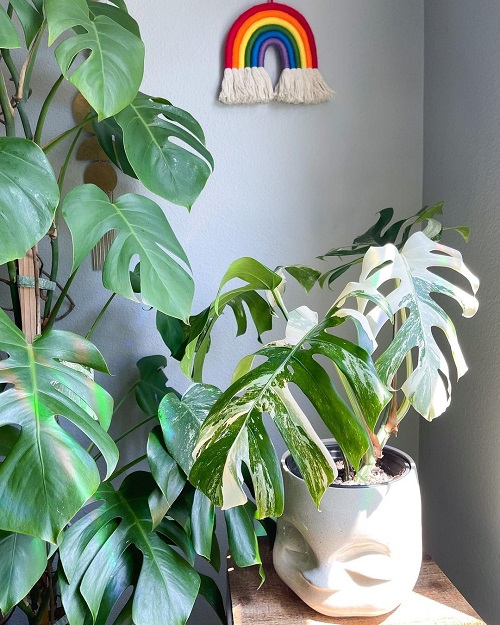
Fertilizer
Go for a balanced liquid fertlizer and dilute it to 1/2 of its strength before feeding Thai Constellation Monstera. Apply it once in 4-6 weeks for best results.
You can also go for Compost, worm castings, or fish emulsion, as they are excellent for providing essential nutrients.
Pruning
Occasional pruning is beneficial for Thai Constellation Monstera . Use clean, sharp scissors or pruning shears to remove dead or yellowing leaves. To encourage bushier growth, trim back leggy stems just above a leaf node.
Prune during the growing season (spring to early summer) to minimize stress on the plant. Regular maintenance keeps the plant healthy and free from pests and diseases.
Check Plants that Look like Monstera but are Not here
Pests and Diseases
Pests:
- Spider Mites: These tiny insects can infest the plant, causing stippling, webbing, and leaf damage. Frequent misting can deter them, and insecticidal soap can help control an infestation.
- Mealybugs: These white, cottony pests cluster on leaves and stems. Remove them manually with a cotton swab dipped in alcohol or use neem oil.
- Scale Insects: These small, round insects attach themselves to the plant and feed on sap. Remove them manually or use neem oil.
Diseases:
- Root Rot: Overwatering or poor drainage can lead to root rot. Ensure the plant is in well-draining soil and allow it to dry between waterings.
- Leaf Spot: Fungal or bacterial pathogens can cause dark spots on leaves. Avoid overhead watering and improve air circulation to prevent this.
- Powdery Mildew: This fungal disease can affect leaves. Use a fungicide if it becomes a problem and ensure good air circulation.
Thai Constellation Monstera – FAQs
1. What Makes Thai Constellation Monstera Unique?
Thai Constellation Monsteras are unique due to their stunning variegated leaves, which feature creamy-white to yellow marbling or spots against a backdrop of deep green. The variegation pattern on each leaf is distinct, making every plant a one-of-a-kind specimen.
2. Is the Thai Constellation Monstera Easy to Care For?
Despite its exotic appearance, the Thai Constellation Monstera is relatively easy to care for. It requires similar care to the Monstera deliciosa: moderate light, well-draining soil, and consistent watering. However, due to its variegated leaves, it might require slightly more light to maintain its vibrant colors.
3. How Fast Does It Grow?
The Thai Constellation Monstera has a moderate growth rate and can reach up to 10 feet indoors with proper care. However, growth may be slightly slower compared to non-variegated Monstera varieties due to less chlorophyll in the leaves.
Check Common Monstera Plant Problems and Their Solutions here
4. Is Thai Constellation Monstera Toxic to Pets?
Yes, the Thai Constellation Monstera is toxic to pets, particularly cats and dogs. Ingesting the plant can cause symptoms like vomiting, drooling, and difficulty swallowing. Keep it out of reach of your furry friends.
5. Where Can I Buy Thai Constellation Monstera?
Due to its rarity and popularity, the Thai Constellation Monstera can be somewhat expensive and is usually available in specialized nurseries or online plant shops. Ensure you’re purchasing from a reputable source to avoid scams or poor-quality plants.
6. How Do I Maintain the Variegation?
To maintain the vibrant variegation, ensure that your Thai Constellation Monstera receives adequate but indirect light. Too little light can result in less variegation, while too much direct sunlight can scorch the leaves.
7. Can It Survive in Low Light?
While the Thai Constellation Monstera can tolerate low light conditions, its variegation may fade, and its growth may slow. For optimal results, place it in a space with moderate to bright, indirect light.

